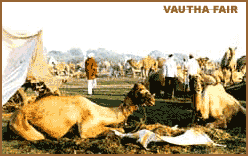 |
 |
|
| VAUTHA FAIR |
|
| Celebrated In
:
Vautha, Gujarat. |
|
| Held at the
confluence of :
Sabarmati & Vatrak. |
|
| Significance :
Major Animal Trading Fair. |
|
| Other
Attraction :
Siddhanath Temple |
|
|
|
| The magnificent Vautha Fair is
held every year at Vautha, where two rivers, the Sabarmati and the Vatrak meet.
Like most fair sites in India, this also has both mythological and contemporary
religious associations. |
|
| The Vautha Mela site is 3 square
miles in area. Legends hold that Kartik Swami or Kartikeya, the son of Lord
Shiva, visited the site. This is why the fair is held during Kartika Purnima,
the full moon night of the month of Kartik, corresponding with November. The
site, also known as Saptasangam, is at the confluence of seven rivers. The most
important Shiva temple here is the temple of Siddhanath. |
|
| TRADE CATTLE
: |
| What is most significant about this fair is
that it is the only major animal trading fair in Gujarat and is on par with the
famous camel fair at Pushkar, Rajasthan. Donkey, cattle and herds of camel are
brought to the site to be traded, at the confluence of seven tributaries of the
river Sabarmati. However, most of the times, the only animals traded here are
donkeys. About 4,000 donkeys are brought every year for sale, usually by
'Banjara' (gypsy) traders. |
 |
|
|
| The donkeys are painted in an
array of colours, and decorated to suit the occasion. Camels are also well
decked up and sold on the sand dunes by the river shores. |
|
| On the day of the full moon night,
pilgrims take dips in the holy river confluence give offerings and pray.
Handicraft and food stalls with tented pastoral settlements come up during the
fair. Kartika Poornima is also celebrated with a camel fair at Sidhpur, a
religious fair at Somnath and a tribal fair at the historic temple of Shamlaji. |
|
| The pilgrims who visit Vautha
during the fair are from several communities and include farmers, labourers and
people belonging to several castes. |
|
|
|
|
|
|
|
 |
 |
|
 |
 |
|
 |
 |
|